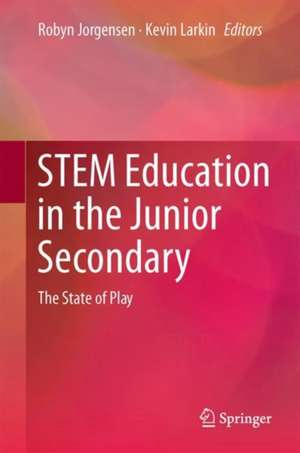STEM Education in the Junior Secondary: The State of Play
Editat de Robyn Jorgensen, Kevin Larkinen Limba Engleză Hardback – 29 aug 2017
While developing this book, the editors drew on two main premises: Firstly, STEM is seen as the integrated study of science, technology, engineering and mathematics in a coherent learning paradigm that is based on real-world applications. Secondly, it is important to integrate digital technologies into STEM education beyond the superficial use of ICTs seen in many schools.
The book also addresses the challenges within STEM education – many of which are long-standing. To this end, it includes chapters o
n marginalised and diverse communities, ensuring that a broad range of perspectives on STEM education is included.
| Toate formatele și edițiile | Preț | Express |
|---|---|---|
| Paperback (1) | 641.71 lei 3-5 săpt. | |
| Springer Nature Singapore – 28 dec 2018 | 641.71 lei 3-5 săpt. | |
| Hardback (1) | 574.39 lei 38-44 zile | |
| Springer Nature Singapore – 29 aug 2017 | 574.39 lei 38-44 zile |
Preț: 574.39 lei
Preț vechi: 717.99 lei
-20% Nou
Puncte Express: 862
Preț estimativ în valută:
109.94€ • 119.46$ • 92.41£
109.94€ • 119.46$ • 92.41£
Carte tipărită la comandă
Livrare economică 17-23 aprilie
Preluare comenzi: 021 569.72.76
Specificații
ISBN-13: 9789811054471
ISBN-10: 9811054479
Pagini: 294
Ilustrații: VI, 294 p. 42 illus., 23 illus. in color.
Dimensiuni: 155 x 235 x 20 mm
Greutate: 0.64 kg
Ediția:1st ed. 2018
Editura: Springer Nature Singapore
Colecția Springer
Locul publicării:Singapore, Singapore
ISBN-10: 9811054479
Pagini: 294
Ilustrații: VI, 294 p. 42 illus., 23 illus. in color.
Dimensiuni: 155 x 235 x 20 mm
Greutate: 0.64 kg
Ediția:1st ed. 2018
Editura: Springer Nature Singapore
Colecția Springer
Locul publicării:Singapore, Singapore
Cuprins
Introduction.- What is unique about Junior STEM?.- STEM and Affect in Adolescence: A Cultural-Historical Approach .- Supporting Students’ Productive Collaboration and Mathematics Learning in Online Environments .- Representation Construction: A Guided Inquiry Approach for Science Education .- Making STEM Curriculum Useful, Relevant and Motivating for Students .- Innovations in Teacher Preparation for STEM: The value of the theory-practice nexus .- Successful Students-STEM Program: Teacher learning through a multi-faceted vision for STEM education .- The Importance of Diagrams, Graphics and Other Visual Representations in STEM Teaching .- Digital Technologies and Junior Secondary: Learning with and about Digital Technologies.- STEM Education in the Brazilian Context: An Ethnomathematical Perspective .- Enlivening STEM education through school-community partnerships .- Inserting Critical Mathematics into STEM Education.
Notă biografică
Robyn Jorgensen (Zevenbergen) has an extensive track record in the study of classroom practice and the implications for equity – particularly for low-SES, indigenous and rural students. She has studied practice in mathematics education and has produced a number of publications in this area. She is internationally recognised as a leader in the study of practice and equity.
Kevin Larkin is a prominent member of the Australian mathematics community and is a member of the MERGA board as VP of Communications. He is an active reviewer for a number of mathematics journals including Mathematics Education Research Journal (MERJ), Mathematics Teaching and Educational Development (MTED), Australian Primary Mathematics Classroom (APMC) and the International Journal for Science and Mathematics Education (IJMTL). He has a strong reputation in the field of digital technologies in Mathematics Education, has presented research on this topic at the last two MERGA conferences, and
has been published in this area in books and mathematical journals.
Kevin Larkin is a prominent member of the Australian mathematics community and is a member of the MERGA board as VP of Communications. He is an active reviewer for a number of mathematics journals including Mathematics Education Research Journal (MERJ), Mathematics Teaching and Educational Development (MTED), Australian Primary Mathematics Classroom (APMC) and the International Journal for Science and Mathematics Education (IJMTL). He has a strong reputation in the field of digital technologies in Mathematics Education, has presented research on this topic at the last two MERGA conferences, and
has been published in this area in books and mathematical journals.
Textul de pe ultima copertă
This book brings together a collection of internationally renowned authors in the STEM field to share innovations in the teaching of STEM. It focuses on the junior secondary years of education (students aged 11-15), since this is the age range in which students choose whether or not to formally opt out of STEM education. It is here that the book makes a significant contribution to the field by integrating the STEM area and focusing on the junior years of schooling.
While developing this book, the editors drew on two main premises: Firstly, STEM is seen as the integrated study of science, technology, engineering and mathematics in a coherent learning paradigm that is based on real-world applications. Secondly, it is important to integrate digital technologies into STEM education beyond the superficial use of ICTs seen in many schools.
The book also addresses the challenges within STEM education – many of which are long-standing. To this end, it includes chapters o
n marginalised and diverse communities, ensuring that a broad range of perspectives on STEM education is included.
While developing this book, the editors drew on two main premises: Firstly, STEM is seen as the integrated study of science, technology, engineering and mathematics in a coherent learning paradigm that is based on real-world applications. Secondly, it is important to integrate digital technologies into STEM education beyond the superficial use of ICTs seen in many schools.
The book also addresses the challenges within STEM education – many of which are long-standing. To this end, it includes chapters o
n marginalised and diverse communities, ensuring that a broad range of perspectives on STEM education is included.
Caracteristici
Addresses key issues regarding STEM in Junior Secondary Education A comprehensive account that disambiguates the complex relationships between the issues in STEM education Addresses key issues in teacher knowledge/beliefs in STEM, which are important in recognising the complex issues leading to student withdrawal from and disengagement with STEM-related disciplines
